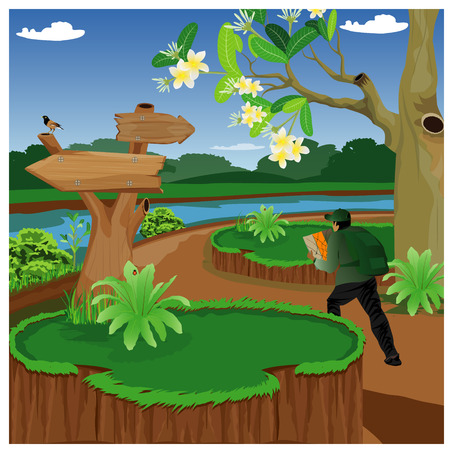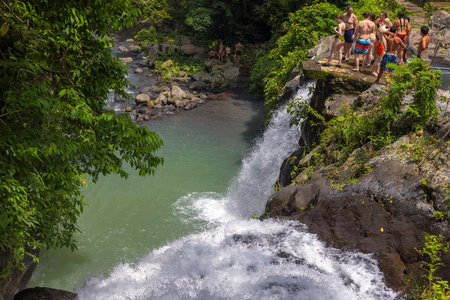1. Setting the Stage: Gujarat’s Untamed Wilderness
Gujarat, often celebrated for its vibrant festivals and colourful textiles, hides a wilder face beneath its tapestry of culture—a realm where deep jungles thrive and monsoon-fed waterfalls carve secret paths through the land. Far from the busy cities and iconic salt flats, Gujarat’s lesser-known forests such as the Shoolpaneshwar Wildlife Sanctuary and the thick woods of Dang beckon with an untamed allure. These jungles awaken during the monsoon, when rain transforms dry riverbeds into roaring waterfalls like Gira and Zarwani, drawing adventurous souls into their embrace.
Trekking in these hidden corners is more than just physical activity; it is a journey that echoes India’s ancient tradition of exploring nature with reverence. The Indian trekking spirit is woven with respect for the land, curiosity about local folklore, and a communal ethos—strangers on the trail quickly become friends, sharing chai under a banyan tree or listening to tribal elders recount legends of forest spirits.
Preparation is rooted in practicality and tradition. Instead of flashy Western gear, you’ll spot trekkers donning sturdy Kolhapuri chappals or canvas shoes, carrying lightweight cotton backpacks (jhola), and wrapping themselves in gamcha scarves to beat the humidity. Essential gear includes steel water bottles (matka-style for that cool sip), packets of homemade theplas or khakra for energy, and always—a small first aid tin filled by mothers’ hands.
In Gujarat’s jungles, every trekker becomes part storyteller, part explorer. The rhythm of waterfalls mingles with tales whispered by the wind, setting the perfect stage for unforgettable journeys into India’s wild heart.
2. On the Trail: Trekking Through Sacred Groves
The journey into Gujarat’s deep jungles begins with a subtle shift in the air—the earthy aroma of moist soil, the distant rush of hidden waterfalls, and the dense green canopy that shields the morning sun. The trek path snakes through sacred groves locally known as ‘Devrai’, revered by tribal communities for generations. These forest patches are not just ecological treasures but also spiritual sanctuaries where every tree and stone tells a tale.
Navigating the Jungle: From Hillocks to Hidden Streams
The trail undulates between gentle hillocks and sudden descents into lush valleys. At each step, you encounter unique flora—towering teak trees (Tectona grandis), fragrant karanj flowers, and sprawling banyan roots that form natural bridges across muddy rivulets. Birdsong is your constant companion; keep an eye out for the vibrant Indian Pitta or the elusive Malabar Whistling Thrush. Occasionally, you might spot langurs leaping across branches or hear the rustle of wild boars in the undergrowth.
Desi Tips & Jugaad Solutions for Trekkers
| Challenge | Desi Tip/Jugaad Solution | Local Term/Practice |
|---|---|---|
| Muddy Slopes | Use bamboo sticks cut by local guides for grip and balance. | Lathi |
| Leeches during Monsoon | Apply a thin layer of mustard oil on shoes and ankles. | Sarson Tel |
| Losing Trail Signs | Look for hand-tied cloth markers or stacked stones left by villagers. | Nishan |
| Dehydration | Refill water at natural springs after checking with locals about purity. | Pani Ka Chashma |
| Wildlife Encounters | Carry a small bell to alert animals and avoid startling them. | Ghanti Lagana |
Trekking Etiquette: Respecting Local Beliefs & Nature
While traversing these sacred groves, always walk in silence near ancient shrines marked with vermillion or turmeric—these are believed to be abodes of forest spirits (van devtas). Avoid plucking flowers or disturbing termite mounds, which are considered sacred by local tribes like the Bhils and Warlis. When in doubt, follow your guide’s advice; their wisdom is shaped by centuries of coexistence with these forests.

3. A Splash of Legends: Folktales by the Cascades
As you pause by the thundering waterfalls deep in Gujarat’s jungles, it isn’t just the cool mist that tingles your senses—there’s an ancient hush in the air, a sense of stories waiting to be told. Our tribal guides, born storytellers with laughter lines etched by forest winds, gather us around and begin weaving age-old Gujarati folklore that has flowed through generations like the rivers themselves.
Echoes of the Ancestors
Here, every waterfall is said to be guarded by a “jal-devta”—a water spirit who rewards respect and punishes arrogance. The elders recall how their forefathers would tie sacred threads on banyan trees before venturing near these cascades, whispering, “Jal nu jatan karo, to jal tamne rakhshe” (Care for the water, and water will care for you). Such idioms are not mere words—they are survival codes forged by centuries in the wild.
Tales That Flow Like Rivers
Under the rhythmic rush of falling water, our guides share the legend of Chanchala Dhara—a restless spirit who roams between streams, searching for her lost anklet. Whenever the jungle echoes with mysterious jingling, locals say, “Paani ma Chanchala farse che” (Chanchala is wandering in the waters). These tales bind community to land, teaching children to tread softly and honor the unknown with reverence.
The Living Bond Between Nature and Narrative
In these deep forests, storytelling isn’t just entertainment; it’s a living tradition that keeps both wisdom and warning alive. As you trek beside tribal elders beneath monsoon-laden clouds, you realize every story is like a trail marker—guiding you through dangers unseen and wonders unimagined. Here in Gujarat’s wild heart, nature and narrative flow together as inseparably as river and rain.
4. Chai Stop: Jungle Kettles and Kutchi Crackers
Every waterfall trek through the deep jungles of Gujarat, especially during the monsoon, is incomplete without a classic chai stop. Somewhere between the echoing waterfalls and thick canopies, the trail often opens up to a clearing—a perfect spot for car-campers to park their vehicles and set up an impromptu tea station. Locals know these jungle lay-bys well, where the aroma of boiling ginger-masala chai mingles with the earthy scent of wet soil.
Mid-Journey Tea Rituals: The Gujarati Way
On these forested routes, sharing chai isn’t just about quenching thirst; it’s an essential social ritual. Trekkers gather around portable kettles and small gas stoves, pouring steaming tea into steel tumblers while exchanging stories or folklore—often about local spirits or ancient Rajput warriors who once crossed these woods. Alongside, Kutchi crackers (spicy mathri or khakhra) are passed around, providing the much-needed crunch and saltiness after hours on muddy trails.
Top Car-Camping Spots for Chai Breaks
| Location | Parking Facility | Scenic Value | Proximity to Waterfall |
|---|---|---|---|
| Polo Forest Rest Area | Ample roadside space | Lush bamboo groves | 15 min walk to mini falls |
| Zarwani Waterfall Entry | Designated lot near gate | Dense teak forest views | 10 min easy trek |
| Shoolpaneshwar Riverside Spot | Mud lay-by (SUV recommended) | Narmada riverbank vistas | 20 min offroad hike |
Gear Essentials: Monsoon-Proof Your Chai Stop!
- Portable Gas Stove: Compact and windproof models work best in unpredictable weather.
- Insulated Kettle: Keeps your masala chai piping hot even if rain delays your journey.
- Reusable Steel Tumblers: Eco-friendly and traditional—a must for authentic Indian chai experience.
- Poncho & Tarpaulin Sheet: Set up a dry corner under sudden showers—vital for both trekkers and car-campers.
- Airtight Snack Tins: Prevent Kutchi snacks from getting soggy in humid air.
This mid-journey break is not just about refueling your body; it’s about soaking up the camaraderie that defines outdoor adventures in Gujarat. As you sip chai amidst dense foliage and distant thunder, you’re not just a traveler—you’re part of an age-old tradition that binds people to the land and its stories.
5. Gear Garage: Must-Have Essentials for West India Treks
Embarking on a waterfall trek in Gujarat’s lush jungles means gearing up for unpredictable monsoon showers, humid afternoons, and slippery trails. Let’s dig into the essential kit that Indian trekkers swear by when heading deep into the wilds of Gir, Saputara, or Dang.
Waterproof Packs & Bags: Keeping Your Kit Dry
No trekker in Gujarat ventures out without a sturdy waterproof backpack. Local brands like Wildcraft and Quechua are popular choices, but seasoned trekkers often double-bag their valuables in polythene or zip-locks—a classic jugaad (hack) against sudden downpours. A rain cover is a must-have for your pack as well, especially during the monsoon months between June and September.
Indigenous Raincoats & Ponchos: The Desi Defence
Forget fancy imported gear—nothing beats the local “plastic chadar” or thick plastic poncho sold at every Gujarati bazaar during monsoon season. These lightweight wraps can be draped over you and your rucksack in seconds. They’re durable, cost-effective, and have saved many a trekker from getting drenched under a roaring waterfall or jungle cloudburst. Some veteran trekkers even recommend traditional “gamcha” (cotton towel) for mopping sweat or improvising as headgear.
Footwear for Slippery Trails
The jungle floor gets treacherously slick near waterfalls. Opt for shoes with aggressive treads—Indian-made Action Trekking shoes or even humble rubber chappals (“Hawai slippers”) are trusted by locals for their grip. Avoid leather shoes; they don’t survive the mud and moisture.
Mobile Cooking Solutions: Chai on the Go
A true Indian trekking experience isn’t complete without fresh chai brewed amidst nature. Most groups carry compact gas stoves (the “camping cylinder” found in Indian markets), lightweight vessels, and pre-mixed masala chai powder. Some prefer traditional earthen pots (“matka”) for an authentic taste. Instant noodles, poha packets, and roasted peanuts are standard trail snacks—energy boosters with a desi twist.
Packing Smart: Extras that Matter
- Torch/Headlamp: Power cuts are common in remote jungles; always carry spare batteries.
- Insect Repellent: Jungle mosquitoes mean business—apply liberally!
- First Aid Kit: Include Dettol, bandages, and Ayurvedic balms like Amrutanjan for muscle relief.
- Reusable Water Bottles: Stay hydrated; tap into fresh streams only after purifying water with tablets or boiling.
Local Wisdom Tip
The best gear isn’t always the priciest—it’s what blends practicality with Gujarati resourcefulness. Ask any local guide, and they’ll show you how to turn a banana leaf into a plate or use neem twigs as natural toothbrushes! Gear up wisely and let the jungle folklore unfold one step at a time.
6. Campfire Chronicles: Night under the Banyan Tree
Notes from a Jungle Night Stay
As twilight drapes over the dense jungles of Gujarat, our vehicle pulls up near a sprawling banyan tree—a sacred sentinel in Indian folklore. The thick roots and leafy canopy offer both protection and an air of mystery, making it the perfect site for our night camp. Setting up begins with a thorough sweep of the ground, clearing leaves and stones to pitch our all-weather Indian tent. For those with SUVs or campervans, rooftop tents are a boon—offering safety from insects and curious animals like the ever-watchful langur or an occasional mongoose. The gentle hum of the forest is interrupted only by the crackling of our portable tandoor, ready to grill some makai (corn) and local bhakri.
Safety Dos and Don’ts
Essential Precautions for Indian Jungles
- Do: Always set up camp at least 100 meters from water sources to avoid wild animal encounters—especially during summer when leopards frequent watering holes.
- Don’t: Never leave food uncovered; pack leftovers into airtight dabbas (boxes) to prevent attracting jungle dwellers.
- Do: Keep a torch (with extra batteries) handy—preferably one with a red light setting to avoid disturbing wildlife.
- Don’t: Avoid loud noises after dusk; instead, use soft voices to blend with nature’s rhythm.
Vehicle-Based Camping Wisdom
If you’re travelling by Mahindra Thar, Force Gurkha, or even a humble Maruti Gypsy, ensure your vehicle is parked on level ground and handbrake engaged. Lay out a perimeter using solar lamps or agarbattis (incense sticks)—the scent helps keep mosquitos away while invoking local tradition. Store valuables inside your vehicle overnight and zip up all tent openings tight; Gujarat’s jungles are home to both inquisitive monkeys and occasional small snakes seeking warmth.
Late-Night Folk Songs in Gujarati
As dinner winds down, the real magic unfolds around the campfire. Our guide, Bhaveshbhai, strikes up a soulful rendition of ‘Halarda’, traditional lullabies once sung by Adivasi mothers. The group joins in for ‘Turiya Turiya Ja’, voices blending with the chirping crickets and distant calls of peafowl. Someone taps on an old steel dabba as makeshift percussion—Indian camping is never complete without jugaad! Sharing stories of legendary vanara (monkey gods) believed to roam these forests, elders pass down myths that make every rustle outside seem alive with ancient spirits.
This seamless blend of practical preparedness and cultural immersion transforms an ordinary night into a memory stitched with Gujarati heritage. Vehicle-based camping in India isn’t just about gear—it’s about respecting local wisdom, honoring jungle lore, and singing beneath stars older than any tale told around our flickering fire.
7. Returning with Reverence: Takeaways & Responsible Trekking
As we emerged from the shadowy canopies and thundering cascades of Gujarat’s remote jungles, a sense of reverence lingered—a feeling that this land is far more than a scenic playground. Every trail tread, every tale shared by tribal elders, and each echoing call of wildlife reminded us that responsible trekking is at the heart of the Indian outdoor spirit. For future explorers, blending adventure with respect for local communities and nature is not just a suggestion, but a necessity rooted in Indian culture.
Respecting Local Communities: The Gujarati Way
The Adivasi (tribal) villages and their guardians are not mere stops along the way; they are the keepers of ancient wisdom and folklore that add soul to every trek. Engage with them humbly—learn a few words in Gujarati or Kutchhi, accept chai with gratitude, and listen to their stories without judgment. Remember, your presence is a privilege. Purchasing local handicrafts or hiring tribal guides directly supports these communities, ensuring your adventure leaves a positive impact.
Leave No Trace: Sacredness in Simplicity
Gujarat’s waterfalls—be it Gira, Zarwani or Chimer—are sanctuaries as much as spectacles. Following “leave no trace” isn’t just global best practice—it aligns with Indian philosophies of ahimsa (non-violence) and shuddhi (purity). Pack out everything you bring in, avoid single-use plastics, and refrain from bathing or washing clothes in pristine pools. Leave wildflowers unpicked and stones undisturbed; let your only footprints be those washed away by the next monsoon rain.
Blending Adventure, Tradition & Sustainability
What sets Indian trekking apart is how it seamlessly fuses thrill-seeking with tradition and ecological responsibility. Local guides often perform small pujas (prayers) before entering sacred groves or approaching waterfalls—a reminder to seek blessings for safe passage and minimal disturbance. Choose homestays over resorts, opt for reusable steel tiffins over disposable packaging, and share transport whenever possible to reduce your carbon footprint.
A Legacy for Future Travelers
Your journey through Gujarat’s deep jungles becomes part of a larger story—one where intrepid souls learn from the land and its people while safeguarding it for generations ahead. As you pack your rucksack for the return journey, carry home not just souvenirs but also new habits: respect for diversity, commitment to sustainability, and a deeper appreciation for India’s wild beauty woven with timeless tales. In doing so, you ensure that the magic of waterfall trekking—and the folklore whispered beneath emerald canopies—remains alive for all who follow.


